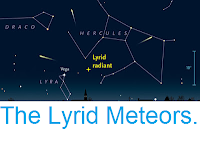The American Meteor Society has
received reports of a bright fireball meteor being seen over Pennsylvania, slightly before 9.15 pm, Eastern Daylight Time, on Friday 25 August 2017 (slightly
before 1.15 am on Saturday 26 August, GMT). The majority of the
sightings came from Pennsylvania, though reports have come from Ohio, West Virginia, Virginia, Maryland, New Jersey, New York,
Connecticut, Rhode Island, Washington DC, and
Massachusetts as well. A fireball
is defined
as a meteor
(shooting star) brighter than the
planet Venus. These are typically caused by pieces of rock burning up in
the atmosphere, but can be the result of man-made space-junk burning up
on re-entry.
Map
showing areas where sightings of the meteor were reported, and the
route of the object (blue arrow). American Meteor Society.
The meteor was seen to move from southeast to northwest, apparently
terminating over the community of Crosby in McKean County, Washington
(such meteors typically terminate many kilometres above the ground in an
explosion caused by friction with the Earth's atmosphere). It has been
described as greenish in colour with an orange tip to its tail, and
burned for about five seconds.
Objects
of this size probably enter the Earth's atmosphere several times a
year, though unless they do so over populated areas they are unlikely to
be noticed. They are officially described as fireballs if they produce a
light brighter than the planet Venus. It is possible, though unlikely,
that this object will have produced meteorites that reached the surface
(an object visible in the sky is a meteor, a rock that falls from the
sky and can be physically held and examined is a meteorite), though most
meteorites come from larger objects that penetrate further into the
atmosphere before exploding, and therefore have a better chance of
producing fragments that reach the surface.
Witness reports can help astronomers to understand these events. If you
witnessed this fireball you can report it to the American Meteor Society here.
See also...
Follow Sciency Thoughts on Facebook.







